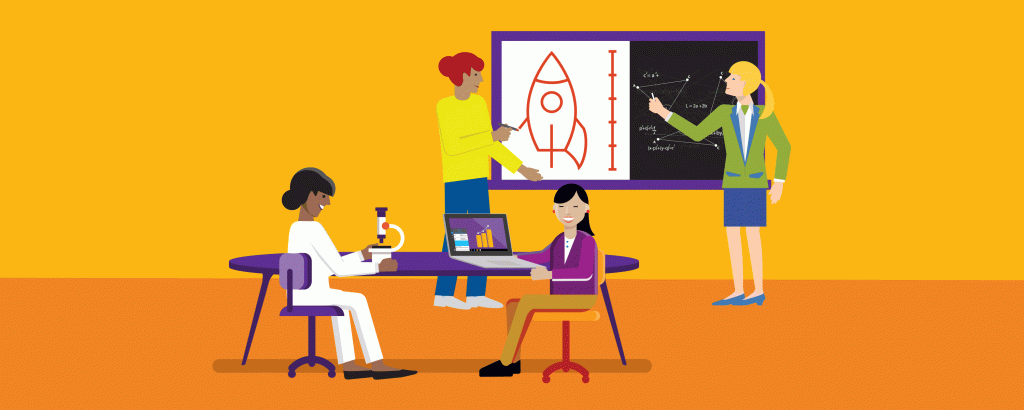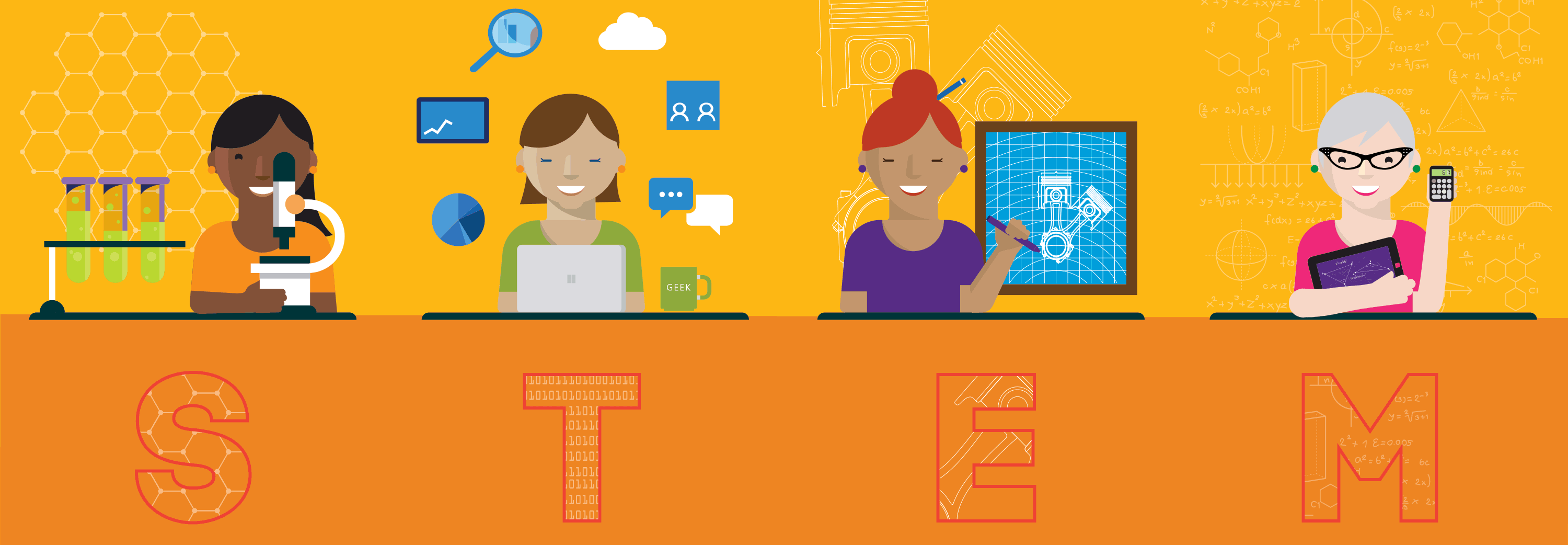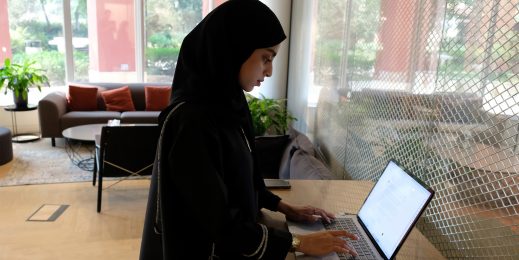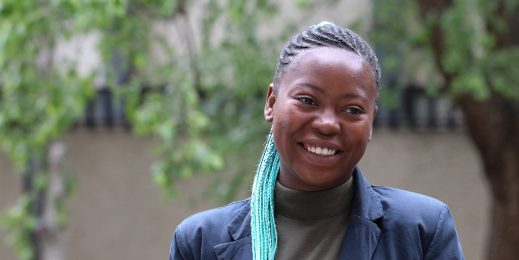
Why don’t European girls like science or technology?
“They say science is quite hard. But I say if you put your mind to it, it’s quite easy.”
Twelve-year-old Paisley Edwards is from the UK, and one of millions of girls across Europe taught science, technology, engineering and maths (STEM) in school.
Like most young women her age, she loves these subjects, which is great for her future career – companies are embracing technology to bring their working practices into the 21st century, and they need digitally-skilled staff to help them with that.
However, ground-breaking research by Microsoft has revealed that most girls’ positive views may change within just a few years. The technology company asked 11,500 women between the ages of 11 and 30 in 12 countries across Europe about their attitudes to STEM. The unique insight found that: Most girls become interested in STEM at the age of 11-and-a-half but this starts to wane by the age of 15.
- Girls cited a lack of female role models in STEM as a key reason they didn’t follow a career in the sector
- Young women are not getting enough practical, hands-on experience with STEM subjects
- Just 42% said they would consider a STEM-related career in the future
- 60% admitted they would feel more confident pursuing a career in STEM fields if they knew men and women were equally employed in those professions
Edwards is lucky, she has a role model: her mum is a scientist at a pharmaceutical company. In comparison, Microsoft’s study found that 61% of Italian girls felt they had access to encouraging role models but just 34% of Dutch girls said the same. One 17-year-old from Germany who took part in the survey said that “parents should always motivate girls”.
If Edwards gets stumped on classwork, she takes it home and asks her mother for help. If her mum doesn’t know the answer, the pair will visit online educational sites and problem-solve together.
“Sometimes when teachers explain [science] it’s not really fun, but my mum, because she knows a lot about it, she explains it more thoroughly and more interestingly,” Edwards said. “She influences me in the way I think about it, so it’s not really boring.”
More than half (57%) of the young European women that Microsoft surveyed said that having a teacher who encouraged them to pursue STEM would make it more likely for them to follow that career path.
As one 11-year-old from France put it: “A good teacher gives life to the subject.”
Janneke Niessen, co-founder of Amsterdam-based advertising technology firm Improve Digital, pointed out it was important that everyone, not just those working in STEM careers, had a powerful ability to influence how girls see themselves.
“It’s really important that men and women think about that when they speak to girls, because often, boys are automatically encouraged in STEM-related subjects and girls are automatically discouraged,” she said.
Having role models and support at home and in the classroom were key drivers for girls wanting to keep studying STEM subjects. Others included gaining practical experiences and hands-on exercises in STEM subjects; learning about real-life applications that show what they can do with STEM subjects and feeling more confident that men and women were treated equally in STEM careers.
A lasting interest in STEM subjects will allow today’s young women to follow in the footsteps of other female scientists and engineers; trailblazers such as Marie Curie, who conducted pioneering research on radioactivity; Florence Parpart, who invented the modern electric refrigerator; Ada Lovelace, who came up with the computer algorithm; Mária Telkes, who made the first solar-powered heating system; and Maria Gaetana Agnesi, the first woman to write a math textbook and first female professor of the subject at a university.
Over the past decade, employment in Europe’s technology sector has grown three times faster than overall employment. Governments, businesses and individuals are learning to adapt to and embrace what has been called the “fourth industrial revolution”. Advances in technology have made autonomous vehicles, robotics, 3D-printing, genetic diagnostics and the Internet of Things more than a reality; they have become commonplace.
This new world needs skilled scientists, engineers and technicians of both genders who have experience in STEM subjects over a long period. Europe could face a shortage of up to 900,000 skilled information and communication technology workers by 2020, according to the European Commission (EC). If we had as many women as men in the digital jobs market, the EU’s annual GDP could be boosted by €9 billion, the EC added.
“There are two reasons why it is important to inspire girls for STEM,” said Sabine Bendiek, Managing Director of Microsoft Germany, whose passion for STEM started at school when a maths teacher introduced her to programming. “On the one hand, because they gain a whole lot of career possibilities – after all, IT-professions and digital literacy are becoming more and more important in our digitized world.
“On the other hand, we need girls in STEM in order to stay economically competitive. Germany is missing thousands of IT specialists. We need women.”

Girls’ interest in STEM during that four-year window between 11-and-a-half and 15 is unquestionable. One 15-year-old in Ireland said: “I like science subjects. I know that I am talented in them and this boosts my self-confidence.” An 11-year-old in Italy said she liked science because “I discover new things”.
Professor Martin W Bauer, from the Department of Psychological and Behavioural Science at the London School of Economics (LSE), who worked with Microsoft on the study, said: “The problem is no longer lack of talent, but talent in the right career path. And one of the key issues is the fact that male and female students continue to make different career choices. Conformity to social expectations, gender stereotypes, gender roles and lack of role models continue to channel girls’ career choices away from STEM fields.
“But there’s a growing movement in our society who not only understands that both STEM and humanities skills are crucial for today’s workforce, but who also care deeply about removing obstacles to gender equality in STEM careers.”
Microsoft’s research found that 70% of British girls and 48% of French girls said they would feel more confident pursuing STEM careers if they knew men and women were equally employed in STEM disciplines.
However, there was an overriding view that girls understood STEM subjects were important.
One 11-year-old French schoolgirl added: “When we do experiments, we learn new things that matter in our daily lives.” A 13-year-old in Poland pointed out that “we need to do more practical experiments so that we can see how things happen in the real world”.
“It would be great to invite a famous female scientist to school. Someone we could relate to and ask for advice,” a 16-year-old in Ireland remarked; while a 15-year-old in France believed “practical examples of what I have learned in physics help me better understand what I’m studying”.
Davida Wilson, a 17-year-old from the UK, believed the importance of learning STEM subjects should not be underestimated. In Year 11 (ages 15 and 16), she and her classmates were encouraged to participate in science: “There was a lot of emphasis on female empowerment and women being able to do anything. We were always encouraged to do as much as we can to represent females in science.”
However, that changed by Year 13 (ages 17 and 18), when educators were focused primarily on teaching students what they needed to know to pass exams, Wilson said.
“In primary school there’s not much exposure to science, but at secondary school it’s something new, so the teacher has a lot of influence on whether you like it,” she said.
To solve the issues raised by Wilson and many other girls her age requires action from governments, schools, companies and parents, as well as young women themselves.
Microsoft is playing its part by running female-focused programs across the world aimed at increasing interest in STEM and building skills. These include DigiGirlz – which allows young women to get an inside look at what it’s like to work at Microsoft and build their digital skills through training and mentoring sessions – and Codess – which aims to inspire female coders and help them achieve their professional goals through networking events, mentoring and sharing advice and experiences.
Various technology training days and mentoring programmes are run by Microsoft in Europe every year, including the IT Girl of the Year award in Sweden, GirlsDay in the Netherlands, Nuvola Rosa in Italy. Although open to boys as well, Code your Life in Germany helps 10 to 14 year olds learn more about digital careers, while Microsoft, UN Women, UNRIC and the ITU held a two-day training and mentoring programme for young women in Venice last year as part of the #MakeWhat’sNext campaign, which aims to introduce girls to role models and give them hands-on experience with the latest technology.
In the UK, an important base for many technology and research companies, Microsoft has partnerships with Girlguiding and Modern Muse – a website that allows women in business to share their workplace experiences in the hope of inspiring youngsters; so far more than 70 “muses” have signed up.

The UK business also recently launched a programme to teach digital skills to people across the UK to ensure the country remains one of the global leaders in cloud computing, artificial intelligence and other next-generation technologies.
“The research reveals that we can’t afford to wait until girls are thinking about university courses to foster their interest in STEM,” said Cindy Rose, Chief Executive of Microsoft UK. “To stop the drop-off in interest in STEM, we’re working with governments, teachers and non-profits to modernise the curriculum and provide better access to mentors.
“That’s why we recently announced a national skills programme to boost digital skills. We also want to show girls that technology can be a creative, fulfilling career, through programmes such as our DigiGirlz camps, which aim to dispel stereotypes associated with the tech industry, as well as our involvement in www.modernmuse.org, which gives girls access to professional women from all industries, including our very own Microsoft muses.”
Learning those digital skills that will help men and women in the future starts with having access to trusted and inclusive technology that is anchored in the cloud. Building a cloud that creates opportunities and serves the broader good requires governments, the tech industry and society to work together to integrate digital literacy into the broader curriculum; create more opportunities for computer science teaching in and out of the classroom; place a greater focus on STEM education as part of the EC’s Skills Agenda strategy; use new technologies to spark girls’ interest in STEM; future-proof teacher training programs and make teaching more collaborative, immersive and social; introduce more creative and hands-on experiences in classes; classes must be gender neutral; partner with governments and the non-profit sector to support digital literacy initiatives; and ensure role models are more visible.
“Young girls need to see that tech is relevant for them, and it’s fun and not that difficult, and it’s really creative,” said Niessen.
“When you have that early on in your life, you find it normal. That helps girls, because if they experience it early on and everybody is treated the same, it’s just like learning a language, and there’s less chance that at a later age they suddenly start feeling, ‘It’s not for me’. They get a chance to start liking it before bias kicks in.”
















